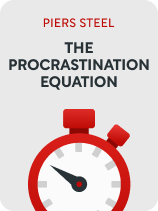

This article is an excerpt from the Shortform book guide to "The Procrastination Equation" by Piers Steel. Shortform has the world's best summaries and analyses of books you should be reading.
Like this article? Sign up for a free trial here.
Do you struggle to feel motivated at work? What are ways to make boring tasks fun?
The Procrastination Equation by Piers Steel points out the obvious: people procrastinate because they’re bored. But procrastination could lead to repercussions, which is why you have to figure out how to turn dull work into fun work.
Discover how to put value in the work you do, no matter how boring it is.
Make the Task More Valuable to You
Steel’s strategy for preventing procrastination is to make boring tasks more interesting (and thus more valuable) to us. In today’s world, most work is broken into routine, repetitive tasks that contribute to monotony and boredom, such as doing inventories, entering data into spreadsheets, and writing reports. We struggle to feel motivated to complete these dull tasks because our brains deem them unimportant. Thus, we procrastinate, and the unpleasant work adds up.
(Shortform note: Repetitive tasks may pose workplace problems beyond just encouraging procrastination. Some research shows that the extreme boredom of repetitive tasks can have serious effects on employees’ mental health, making them dissatisfied, dispirited, and desperate to leave the job. When turnover increases, companies incur costs for recruiting and lose time training new employees. Additionally, tasks that involve repeated movements often lead to health problems like tendonitis and carpal tunnel syndrome.)
The following techniques will help you make boring tasks more interesting and valuable:
Technique #1: Make the Task (Somewhat) More Challenging
Steel states that you can make a task more enjoyable and avoid procrastination by making it a little more challenging. Tasks that are too easy become boring because there’s no novelty left in them—they’re inherently repetitive since you know exactly what to do and how to do it. Adding some difficulty reintroduces novelty, making the work more valuable and interesting.
Steel argues that this works as long as you don’t make a task too challenging—if you do, you might become overwhelmed and procrastinate anyway. You experience maximum engagement when you’re able to strike an appropriate balance of difficulty. This allows you to access flow states where you’re completely engrossed in a task—still learning new things and improving, but undeterred by what you’re not yet able to do.
One way to make a task more challenging is to turn it into a game or competition. For example, you could treat your tasks like quests in a video game, where you must complete each one within a certain amount of time. Each time you succeed, you get points to trade in for real-life rewards, such as a meal at your favorite restaurant. The limited time adds a challenge, and the reward system makes the work more fun.
(Shortform note: If you want a little creative guidance to help you gamify everyday tasks, some companies have products designed for this purpose. For example, The Hero’s Journal is a daily journal you complete over 90 days that transforms your goals into quests. You write in it every day to track your progress, and you experience a story along the way.)
| How to Make Tasks More Challenging and Access Flow States If a work task feels too easy, you can also make it more challenging and engaging by exercising different skills. For instance, use problem-solving skills to make your workflow more efficient. Additionally, increase your expertise in the task, instead of sticking with a basic understanding of it. Learn the ins and outs of the processes, software, and systems involved in the task. In Flow, Mihaly Csikszentmihalyi describes how you can use this iterative learning process to access flow states even as you acquire skills that make previously challenging tasks feel easy (and therefore unengaging). He argues that flow states balance ease with challenge to create an enjoyable experience. According to Csikszentmihalyi, you enter and exit flow states at different stages of pursuing a goal. When you first start an activity, you enter the first flow state, where you’re accumulating the collection of skills needed to do the activity. Once you achieve your first goal, previous challenges are now easy, and you exit the flow state, instead entering a state of boredom and anxiety. To leave this anxious, bored state and enter a new flow state, you must create new goals and practice new skills. |
Technique #2: Attach Boring Tasks to Important Goals
Steel’s second technique for adding value to tasks involves attaching the tasks to goals that are important to you. When we associate responsibilities with goals we already care about, they become inherently motivating instead of things that we’re obligated to do. Even the most mundane tasks become relevant to bringing your vision of the future to life. Therefore, you’re less likely to procrastinate them.
For example, maybe you hate exercising. However, one of your long-term goals is to travel to places that require a lot of physical activity to get around. Therefore, you need to get in shape and get stronger. Every time you have the urge to procrastinate on going to the gym, remind yourself that each exercise session brings you closer to your goal of being able to walk and hike wherever you want. Think of all the beautiful sights you’ll get to see and the experiences you’ll get to have, and let that be your motivation.
(Shortform note: To reflect on the relationship between tasks you dislike and your broader goals, The Bullet Journal Method author Ryder Carroll suggests journaling. First, identify the tasks you find difficult and unpleasant. Then, on the left side of the page, write how each task makes you feel. For example, “I hate meal planning for the week because it’s so frustrating to have to decide what I want to eat in advance.” On the right side of the page, write how the tasks ultimately benefit you. (This benefit could include whatever goal you connect it to.) For example, “Planning ahead makes it easier to choose healthy options and prevents me from exceeding my grocery budget.”)

———End of Preview———
Like what you just read? Read the rest of the world's best book summary and analysis of Piers Steel's "The Procrastination Equation" at Shortform.
Here's what you'll find in our full The Procrastination Equation summary:
- Strategies to help procrastinators increase their motivation and control
- How to make unpleasant tasks feel more valuable for yourself
- Why procrastinators are typically less financially successful






